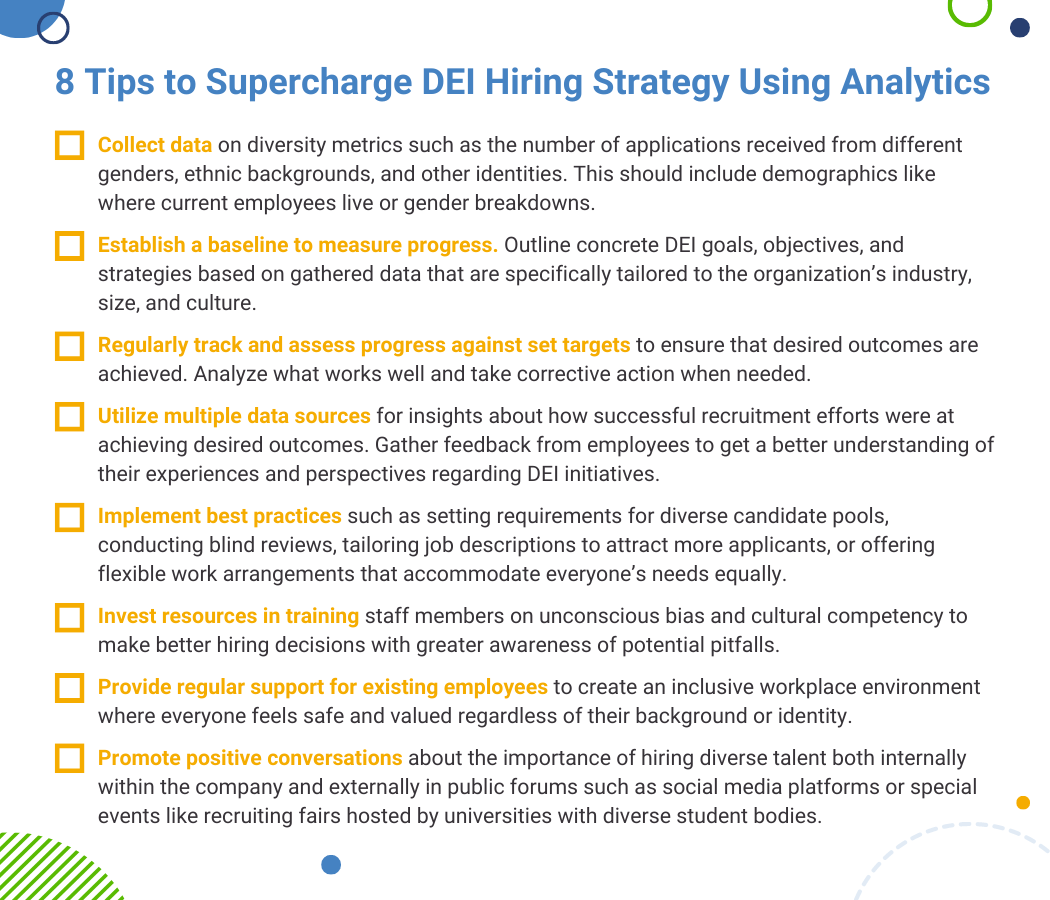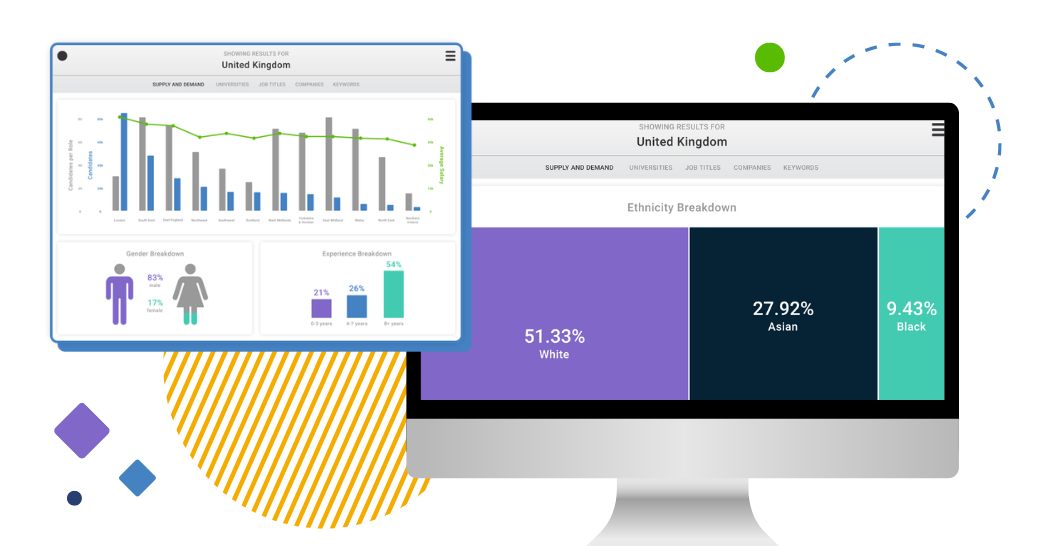As the workforce becomes increasingly diverse, companies need to reflect that diversity in their hiring. But how can you ensure that you're hiring for a diverse team if you're not tracking the right metrics?
Diversity analytics can help you identify where your company needs to catch up and give you the data you need to make meaningful changes. This blog post will show you how diversity analytics can help promote a more diverse workforce.
Read more: What Are Labor Analytics Anyway?
Companies are increasingly tracking diversity metrics to ensure they hire a diverse workforce and create an inclusive environment. These metrics may include the number of applications received from different genders, ethnic backgrounds, other identities, shortlisted applicants, and appointments made.
Companies also look at the diversity of their workforce in comparison to their target customer base, industry, or country averages. Data points such as age ranges, job tenure, manager/direct report ratio, and organizational density can help identify areas for improvement concerning fairness and opportunity within the organization.
What are Companies Doing Today? See What Our Survey Shows.
Our survey results indicate that most businesses actively take the initiative to measure and monitor their progress toward workplace equality. 60% of respondents reported that they are currently utilizing diversity metrics across their entire organization, while 14% reported that they have yet to incorporate this practice into their hiring process. In addition, 26% of those surveyed had plans to begin employing diversity metrics in the future. These findings demonstrate a positive upward trend for companies looking to commit resources to establish and create an equitable, diverse workplace.
Getting into the habit of regularly collecting market data on diversity is key for any organization wishing to build an inclusive team. With diversity being such a priority for many businesses today, tracking trends across the industry and finding intelligent ways to hire for diversity should become a more significant part of any comprehensive organizational strategy.
Why is this important?
Tracking these metrics ensures long-term success in achieving workplace diversity objectives. It helps employers identify areas that need additional attention, such as those related to recruitment, promotion, and retention practices—all of which play an important role in closing the existing gap between goals and reality.
Hiring for diversity starts with recognizing that a more diverse and inclusive workforce can bring various benefits to companies: reduced costs associated with employee turnover, increased access to larger talent pools, and the promotion of creativity and ingenuity. And this is why tracking diversity metrics is so important: it helps create an environment of transparency and builds trust between employers and their diverse workforce. By equipping organizations with better insights into the effectiveness of their efforts, they can identify areas that need improvement, assisting in closing the gap between goals and reality.
Read More: Why do you need ethnicity data? Because diverse organizations are high-performing ones. A study showed diversity was a driver of innovation - diverse teams produce 19% more revenue, among other benefits. Workplace diversity also leads to creativity – more diverse teams lead to a myriad of diverse viewpoints, which in turn increases diverse solutions.
How can you use diversity analytics to your advantage when hiring new employees?
Organizations must prioritize implementing effective strategies that center both data-driven decisions and tangible goals so they can effectively monitor progress over time and analyze how successful their efforts were at achieving desired outcomes. With more businesses embracing the importance of monitoring diversity metrics within their operations, it's clear that we're making progress toward creating a more inclusive environment.
You must look in many places to find and attract people with different backgrounds. You can use surveys to ask questions about how well your organization is doing at hiring a diverse workforce. This will help you understand what areas need improvement so that you can work on recruiting people with different backgrounds and experiences. Having goals and plans to track your efforts' success is essential. Diversity analytics is also helpful because it gives companies better insights into their progress, allowing them to make more informed decisions when hiring new employees. Additionally, why not try Horsefly Analytics’ latest data set: Ethnicity Data? This new functionality allows you to map out the ethnicity for any combination of skills or job titles below across multiple locations.
When it comes to hiring for diversified workplaces, having a data-driven approach is crucial for success. By tracking diversity metrics - like where current employees live or the gender breakdown of applicants - organizations can make more informed decisions about their workforce and how well they achieve hiring goals. This type of analytics provides much-needed insight into the fairness of an organization’s hiring practices, allowing them to refine its processes and ensure a more equitable future. With an increasing number of companies utilizing these cutting-edge diversity tools, it may be time for businesses to leverage similar approaches to foster real change and promote a comprehensive effort toward true workplace inclusivity.
In addition to examining the demographic makeup of their workforce, companies may also look at qualitative data such as employee engagement surveys or exit interviews to gain a deeper understanding of how people experience working within the organization. This data can be used to measure workplace culture and identify any potential issues that need addressing to ensure all employees feel valued and respected and have equal opportunities for development and growth.
While tracking demographic data is key to discovering and addressing diversity gaps in the workplace, it can only reveal part of the picture. Companies must also look at qualitative data such as employee engagement surveys and exit interviews to gain a more expansive understanding of how their workforce interacts with one another, their work environment, and the opportunities available to them. This kind of data provides a valuable window into cultural dynamics that may be driving performance issues or exclusionary practices. Examining this kind of data can help management identify areas for improvement and empower employees in ways that create an inclusive team dynamic and promote equal opportunity for development and growth.
How can you overcome these challenges and ensure your workforce is truly diverse and inclusive?
An effective way to ensure a truly diverse and inclusive workforce is to track diversity metrics. While only 60% of companies have reported tracking diversity metrics, employers still need to create a system dedicated to tracking DEI efforts. Companies that strive to hire an assortment of individuals with different backgrounds, cultures, and experiences initiate a work environment that fosters innovation and productivity.
By monitoring diversity metrics, employers can be held accountable if actual hiring numbers do not match the expectations they have set for themselves. To build a successful team, hiring decisions must focus on talent rather than stereotypes or biases. Therefore, incorporating diversity metrics into the selection process makes sense as part of many companies' mission toward inclusivity.
To ensure your workforce is diverse and inclusive, you should keep track of the different types of people you hire. You should also look at how people who work in your company feel about their work. This data can help you find ways to make sure everyone feels included and respected and has equal chances to learn and grow. You should focus on hiring the best person for each job instead of making decisions based on stereotypes. Tracking diversity metrics will help hold employers accountable for not reaching their goals of creating a diverse workplace.
The HOW of DEI Hiring
Companies must stay ahead of the diversity hiring curve to ensure that every applicant is given an equal opportunity in their recruitment processes. Organizations may benefit from utilizing third-party services to remove any conscious and unconscious bias from their decision-making.
Dabbling in external labor market trends or diversity research findings can further strengthen diversity initiatives for under-represented talent pools and make them more diverse. Companies can use traditional diversity metrics and more advanced techniques, such as AI-driven diversity hiring algorithms, when conceptualizing their diversity hiring strategy. This way, everyone has the same opportunity to reach their full potential without fear of discrimination or favoritism.

Hiring with diversity in mind is fundamentally different from the traditional recruiting approach merely based on qualifications and skills. Instead, by considering aspects such as race, gender, age, sexual orientation, religion, and other social identities, companies can ensure that their workforce more accurately reflects the society they operate in. This helps to foster an environment of respect and understanding, allows for innovation and collaboration, and ultimately creates an inclusive workplace.
Organizations can also implement strategies such as increasing the number of job postings on diverse job boards or adopting methods like blind hiring to remove any unconscious bias that may exist.
Leadership and DEI: Hand in Hand
Leadership is integral in creating and enabling a truly diverse and inclusive workforce. Leaders must be active in setting the tone for their organization, promoting a culture of equality and respect, and providing guidance to ensure everyone is given equal opportunities to grow and succeed. Leaders must strive to create an environment of mutual trust, understanding, and open dialogue that encourages employees to bring their full selves to work.
Employers must make a conscious effort to ensure that their workforce is diverse and inclusive. This involves hiring with diversity in mind, tracking progress over time, and ensuring everyone feels welcome and included in the workplace. It is vital for leaders to take an active role in fostering an inclusive work environment and creating equal opportunities for everyone. With the right strategies and actions in place, employers can build a workforce that reflects their society, enabling them to reap numerous benefits such as increased productivity, creativity, innovation, and collaboration.
While the number of companies tracking DEI analytics has increased in recent years, there is still room for improvement. Diversity in the workplace has been shown to have countless benefits, from improved job satisfaction and employee retention rates to decreased instances of lawsuits tied to discrimination.
By understanding your workforce demographics and using this data to inform your hiring decisions, you can ensure that your company is reaping all the benefits of a diverse workforce. However, challenges such as unconscious bias can make creating a truly inclusive environment difficult. Luckily, by being aware of these potential obstacles and taking steps to mitigate their impact, you can build an innovative and high-performing workforce that reflects the world around us.
Are you interested in learning more about using labor market data to hire for diversity? Click here to book a free consultation with one of our expert analysts.
